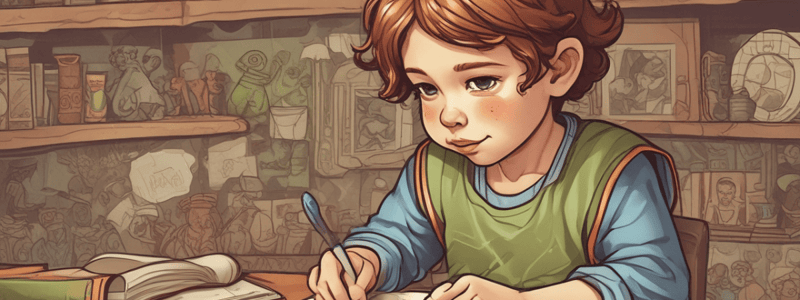Podcast
Questions and Answers
What is the primary goal of adults waiting and observing children during outdoor play?
What is the primary goal of adults waiting and observing children during outdoor play?
- To respect children's agency and support their natural inclinations towards exploration (correct)
- To intervene immediately and correct the children's actions
- To provide constant supervision and ensure safety above all
- To dictate the rules and structure of the play
What is an outcome of adults adopting a child-centered approach during outdoor play?
What is an outcome of adults adopting a child-centered approach during outdoor play?
- Children develop a love for learning and interaction that extends beyond the play environment (correct)
- Children's growth is limited to physical development
- Children become isolated from their peers and Prefer adult interaction
- Children become completely dependent on adults for guidance
How do adults show respect for children's play?
How do adults show respect for children's play?
- By acknowledging their competence and showing interest in their activities (correct)
- By providing constant feedback and correction
- By ignoring the children and letting them play alone
- By taking control of the play and dictating the rules
What is a benefit of adults connecting with children on a deeper level?
What is a benefit of adults connecting with children on a deeper level?
What is the outcome of adults implementing the strategy of waiting and observing, followed by selective participation?
What is the outcome of adults implementing the strategy of waiting and observing, followed by selective participation?
Why is it important for adults to navigate social challenges with children?
Why is it important for adults to navigate social challenges with children?
What is a key aspect of the strategy of waiting and observing, followed by selective participation?
What is a key aspect of the strategy of waiting and observing, followed by selective participation?
What is the result of adults showing respect for children's autonomy during outdoor play?
What is the result of adults showing respect for children's autonomy during outdoor play?
What is the focus of a child-centered approach during outdoor play?
What is the focus of a child-centered approach during outdoor play?
What is the ultimate goal of supporting children's outdoor play experiences?
What is the ultimate goal of supporting children's outdoor play experiences?
Study Notes
The 17 Second Strategy
- A technique for teachers and caregivers to support children's problem-solving skills, patience, and resilience by waiting at least 17 seconds before intervening in a challenge.
- Gives children space and time to work through difficulties, communicating trust in their abilities and providing opportunities for problem-solving, patience, and a sense of accomplishment.
Understanding the Strategy
- The 17-second wait allows children to process a problem and consider solutions, and immediate intervention can undermine confidence and hinder problem-solving skills.
Implementing the Strategy
- Observe and assess the child's approach to the problem, understanding their level of engagement and effort.
- Wait and support the child, maintaining a supportive presence through body language, facial expressions, or simple statements.
- Reflect and discuss with the child after they've worked through the problem, asking open-ended questions about their process, feelings, and learning.
Benefits of the Strategy
- Enhances problem-solving skills by giving children time to work through problems independently.
- Increases patience and resilience by teaching children that problems take time to solve and persistence is valuable.
- Boosts confidence in children's abilities by successfully solving problems or attempting to do so.
- Fosters independence by giving children opportunities to solve problems on their own.
Strategy 3: Wait & Observe
- A strategy for adults to support children's outdoor play experiences by patiently observing and selectively participating.
- Creates a nurturing environment that stimulates children's natural curiosity, creativity, and social development.
Understanding the Strategy
- Children are inherently motivated to explore, create, and interact with their environment and peers, and adults can gain insights into their interests, challenges, and social dynamics by observing.
Implementing the Strategy
- Patiently observe children's play without immediate intervention, being attentive and ready to engage when necessary.
- Selectively participate in ways that enrich the play experience, such as offering materials, asking open-ended questions, or mediating social conflicts.
- Encourage inquiry and creativity by providing materials that spark imagination or posing questions that stimulate scientific inquiry.
- Facilitate social growth by observing how children interact and guiding them in developing social skills.
Benefits of the Strategy
- Creates enhanced learning opportunities that are aligned with children's interests and developmental needs.
- Increases autonomy and confidence in children's abilities by giving them the lead in their play.
- Strengthens social skills by supporting children in practicing and developing social skills in outdoor play.
- Deepens connections between adults and children, showing respect for their play and acknowledging their competence.
Studying That Suits You
Use AI to generate personalized quizzes and flashcards to suit your learning preferences.
Description
Learn how to support children's problem-solving skills, patience, and resilience with the 17-second wait strategy.




